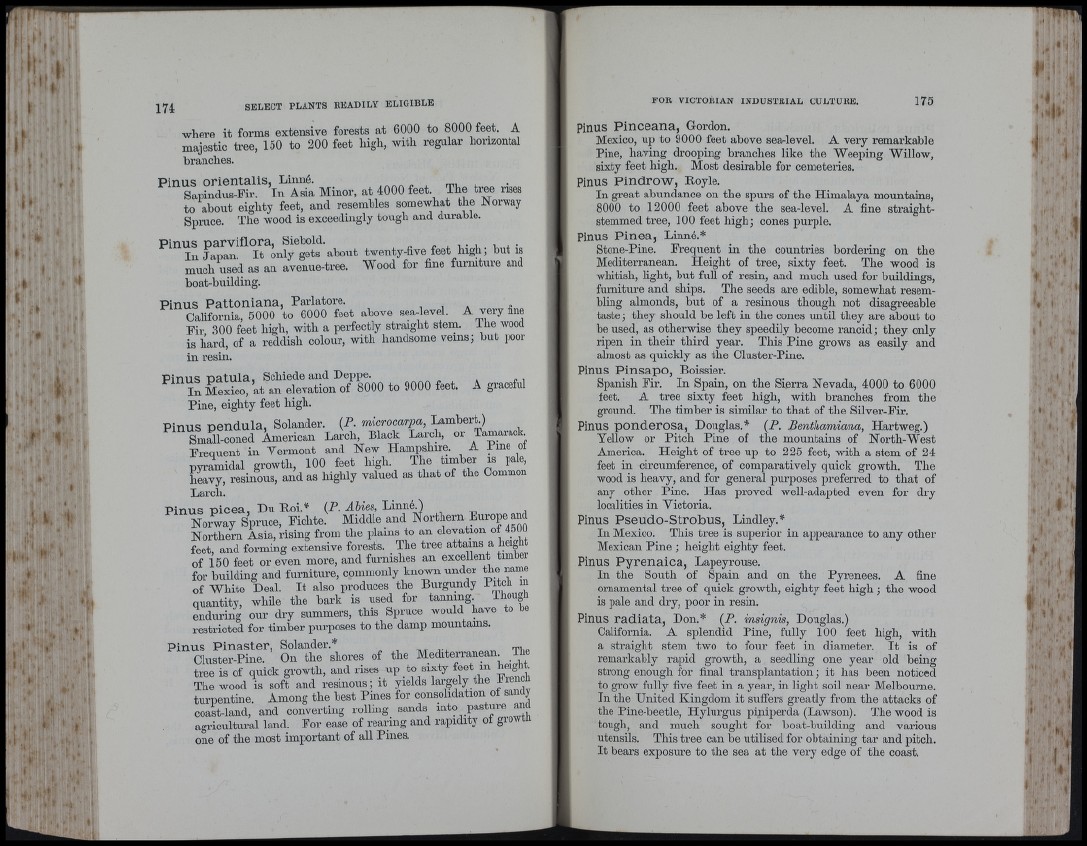
? ; r
M
!
âil
I il
A \ '
G ' f ; ■
' I <
; I
« î V
* t1 ■ 1 ' : 1 jf * ' ' . , \
t i " ' .
■ *. if
= I ’
É
l£ii
» ■«
t;
. t
c
' f!
. " Jl
SELECT PLANTS READILY ELIGIBLE
where it forms extensive forests at 6000 to 8000 feet. A
majestic tree, 150 to 2 0 0 feet high, with regular horizontal
branches.
P inii'? orientalis, Linné. _
Sapindm-Fir. In Asia Minor, at 4000 feet The tree rises
to about eighty feet, and resembles somewhat the Norway
Spruce. The wood is exceedingly tough and durable.
Pinus parviflora, Siebold. x. , i,- i vs . -
In Japan. I t only gets about twentyttye feet high; but is
much used as an avenue-tree. Wood for fine furiutuie and
boat-building.
Pinus Pattoniana, Parlatore. , i * «
California, 5000 to 6000 feet above sea-level. A very fine
F ir 300 feet high, with a perfectly straight stem. Tlie wood
is hard, of a reddish colour, with handsome veins; but poor
in resin.
Pinus patula, Schiede and Deppe. ^ * pi
In Mexico, at an elevation of 8000 to 9000 feet. A graceful
Pine, eighty feet high.
P in u s p e n d u l a , Solander. (P. micromrfo., Lambert)
Tm ill-c o n e d American Larch Black Lareh, or Tamar^k
Frequent in Vermont and New Plampsbire. A luie
p v r liid a l growth, 100 feet high. The timber k paie,
heavy, resinous, and as highly valued as th a t of the Common
Larch.
Pinus picea, Du Roi.* (R. Ahies, Linné.)
Norway Spruce, Fichte. Middle and Northern E u r o ^ ^ d
Northern Asia, rising from the plains to an elevation of 46M
feet, and forming extensive forests. _ The tree attains a height
of 150 feet or even more, and furnishes an excellent timbe
for building and furniture, commonly known under Hie name
of White Deal. I t also produces the Burgundy Pitch m
quantity, while the bark is used for tanning Though
enduring our dry summers, this Spruce would have to be
restricted for timber purposes to the damp mountains.
Pinus Pinaster, Solander.* ,
Cliister-Bine. On the shores of the Mediterranean. Tl
tree is of quick growth, and rises up to sixty feet in heignt.
The wood is soft and resinous; it yields largely the French
turpentine. Among the best Pines for consolidation of san^
coast-land, and converting rolling sands "Ytnwth
agricultural land. For ease of rearing and rapidity of giowtli
one of the most important of all Bines.
FOR VICTORIAN INDUSTRIAL CULTURE. 175
Pinus Pinceana, Gordon.
Mexico, up to 9000 feet above sea-level. A very remarkable
Pine, having drooping branches like the Weeping Willow,
sixty feet high. Most desirable for cemeteries.
Pinus Pindrow, Royle.
In great abundance on the spurs of the Himalaya mountains,
8000 to 12000 feet above the sea-level. A fine straightstemmed
tree, 1 0 0 feet high; cones purple.
Pinus Pinea, Linné.*
Stone-Pine. Frequent in the countries bordering on tbe
Mediterranean. Height of tree, sixty feet. The wood is
whitish, light, but full of resin, and mucli used for buildings,
furniture and ships. The seeds are edible, somewhat resembling
almonds, but of a resinous though not disagreeable
taste; they should be left in the cones until they are about to
be used, as otherwise they speedily become rancid; they only
ripen in their third year. This Pine grows as easily and
almost as quickly as the Cluster-Pine.
Pinus Pinsapo, Boissier.
Spanish Fir. In Spain, on the Sierra Nevada, 4000 to 6000
feet. A tree sixty feet high, with branches from the
ground. The timber is similar to that of the Silver-Fir.
Pinus ponderosa, Douglas.* (P. Benthamiana, Hartweg.)
Yellow or Pitch Pine of the mountains of North-West
America. Height of tree up to 225 feet, with a stem of 24
feet in circumference, of comparatively quick growth. The
wood is heavy, and for general purposes preferred to th a t of
any other Pine. Has proved well-adapted even for dry
localities in Victoria.
Pinus Pseudo-Strobus, Lindley.*
In Mexico. This tree is superior in appearance to any othei'
Mexican Pine ; height eighty feet.
Pinus Pyrenaica, Lapeyrouse.
In the South of Spain and on the Pyrenees. A fine
ornamental tree of quick growth, eighty feet high ; the wood
is pale and dry, poor in resin.
Pinus radiata, Don.* (P. insignis, Douglas.)
California. A splendid Pine, fully 100 feet high, with
a straight stem two to four feet in diameter. I t is of
remarkably rapid growth, a seedling one year old being
strong enough for final transplantation ; it has been noticed
to grow fully five feet in a year, in liglit soil near Melbourne.
Tn the United Kingdom it suffers greatly from the attacks of
the Pine-beetle, Hylurgus piniperda (Lawson). The wood is
tough, and much sought for boat-buildiiig and various
utensils. This tree can be utilised for obtaining ta r and pitch.
It bears exposure to the sea at the very edge of the coast.
i i i i ;
. I'
h,
, ■ 1 I
■ ■ ’ ■ 4 ■
?